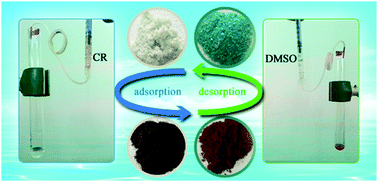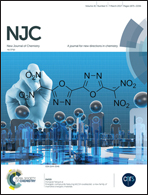Three β-octamolybdate-based supramolecular hybrids constructed from a bis-imidazolyl-bis-amide ligand: fast and selective adsorption activities of organic dyes†
Abstract
Three β-octamolybdate-based supramolecular hybrids assembled from a semi-rigid bis-imidazolyl-bis-amide ligand, [ML(β-Mo8O26)0.5(H2O)]·H2O [M = Co (1) and Zn (2)] and [Cu2L2(H2O)](β-Mo8O26)·4H2O (3) [L = 1,2-bis(1H-imidazole-4-carboxamido)hexamethylene], have been hydrothermally synthesized, and characterized by FT-IR spectrometry, powder X-ray diffraction (PXRD), thermogravimetric (TG) analyses, and single-crystal X-ray diffraction. Compounds 1 and 2 are isostructural, in which the circular units [M2L2]4+ are linked by [β-Mo8O26]4− polyoxoanions to give a 1D chain, which is further extended into a 3D supramolecular structure through hydrogen bonds. A kind of 1D wave-like chain [Cu2L2(H2O)]4+ is linked by [β-Mo8O26]4− polyoxoanions via hydrogen bonds, constructing a 3D supramolecular structure in compound 3. The adsorption behaviours of compounds 2 and 3 for organic dyes were investigated in detail. The results indicate that 2 and 3 show fast and selective adsorption and desorption activities for Congo red, as well as excellent stability and recyclability after ten cycles.

- This article is part of the themed collection: Celebrating Excellence in Research: 100 Women of Chemistry


 Please wait while we load your content...
Please wait while we load your content...